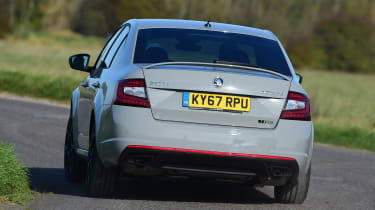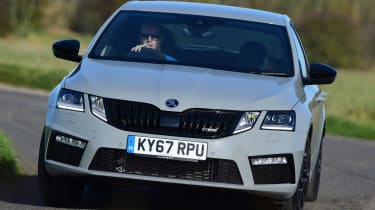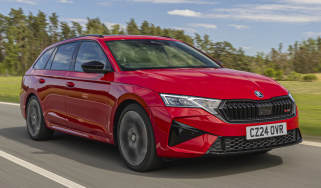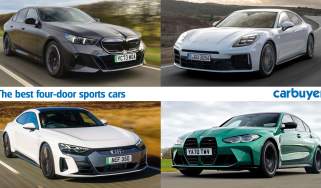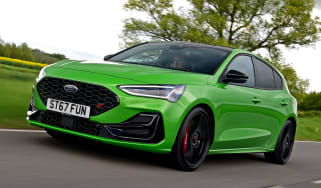Skoda Octavia vRS hatchback - Engines, drive & performance
Both the petrol and diesel models of the Skoda Octavia vRS are powerful and handle well in corners
The Skoda Octavia vRS is a well engineered and good-to-drive hatchback. It shares many components with the Volkswagen Golf and SEAT Leon and while it’s bigger and heavier than both of those cars, it still feels responsive and enjoyable to drive.
The vRS boasts precise steering and very little body lean in corners, with the wide tyres ensuring there’s lots of grip. The stability control does a good job of gently metering out power as you exit tight bends, so you don’t suffer from the steering tugging from side-to-side as the front wheels struggle to grip the road under acceleration. This is even more noticeable in the 2.0-litre turbocharged petrol model thanks to its front differential – a device that sends more power to the wheel with the most grip to improve acceleration out of tight corners.
Driving fun can also be enhanced with a press of the vRS button, which sharpens throttle response and adds a little extra weight to the steering for a more involving feel. The steering is accurate enough, but is a little less direct than that of the smaller Golf GTI, Peugeot 308 GTi and Hyundai i30 N, simply because the Octavia is a longer, heavier model. If you drive the vRS really hard, you’ll encounter some body lean in corners, but there’s plenty of grip and you never feel the car is at risk of leaving the road.
The flagship vRS Challenge is arguably the most fun Octavia we’ve ever driven, not only because it’s the fastest, but because it gets the advanced electronic front differential from the Golf GTI, tuned by Skoda. Press the vRS button here and the suspension, throttle and even the exhaust all become sharper, turning the Octavia into a true enthusiast's car.
More reviews
On both diesel and petrol versions, the suspension is firm and this means the Octavia vRS can feel a bit harsh over poor-quality roads, especially with 19-inch wheels fitted. As of 2017, buyers can choose the £850 Dynamic Chassis Control (DCC) system, which can firm up or soften the suspension - it comes as standard on the vRS Challenge model. On smooth roads, choosing the comfort mode gives a slightly more comfortable ride. Impressively, the car will automatically adopt the sport mode if an accident is imminent, as it enables the car to stop and take avoiding action more readily. It also has an efficiency mode, which can reduce the effectiveness of the air conditioning, and even limit the amount of time the car's cornering lights are on, all in the pursuit of reducing fuel consumption.
The vRS is available with either a six-speed manual or DSG dual-clutch automatic gearbox, although the manual isn't available on diesel models. The manual has a precise shift action and the clutch pedal isn’t too heavy but for ease of use, the DSG takes some beating. Leave it in auto mode and it drives like any other automatic, or you can shift manually using either the gearlever or paddles mounted on the steering wheel. However, it costs significantly more than the manual.
Most drivers will be untroubled by the difference between the petrol and diesel version, but the latter feels very slightly less agile because of the extra weight of its engine. Upgrading to four-wheel drive adds the reassurance of extra grip in icy, damp and slippery corners, as well as a better ability to pull away from a rest on grassy surfaces, but unless you regularly encounter such conditions, we don’t see it as essential.
In general, the vRS is a very composed car that’s easy to drive quickly. It’s not quite as sharp as a VW Golf GTI or Peugeot 308 GTi, but it’s more comfortable on rough road surfaces, which gels well with its family-friendly nature.
Skoda Octavia vRS petrol engine
The 242bhp 2.0-litre TSI turbocharged petrol engine is excellent. It has lots of power at low revs and responds almost instantly when you press the accelerator. Keep going towards maximum revs and the performance keeps building. There’s also a fruity exhaust note when accelerating hard, yet it remains quiet at a steady cruise - the best of both worlds.
With the six-speed manual gearbox, the vRS will reach 62mph from rest in 6.7 seconds, compared to the 6.5 seconds taken by the Golf GTI. In the real world, you’ll hardly notice that difference, and the petrol Octavia vRS never feels sluggish, with effortless overtaking power when you need it.
Diesel engine
Skoda was one of the first manufacturers to sell performance diesel hatchbacks. And while you’ll have to sacrifice some performance compared to the petrol model, the diesel’s extra in-gear shove means there’s instant response from low revs when you press the accelerator, which is great for safe overtaking. The diesel takes longer to hit 62mph from a standing start than the petrol, but its 8.1 second 0-62mph time with a manual gearbox is far from slow. The 4x4 model is the quickest diesel. It does 0-62mph in 7.6 seconds, making it half-a-second quicker than the two-wheel-drive version.

